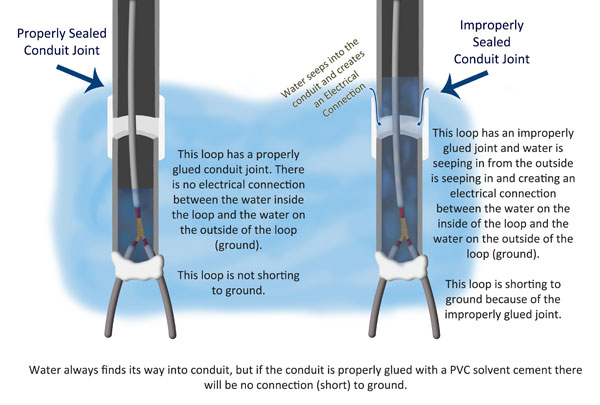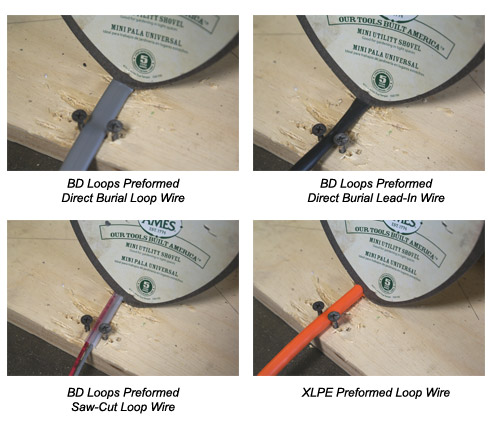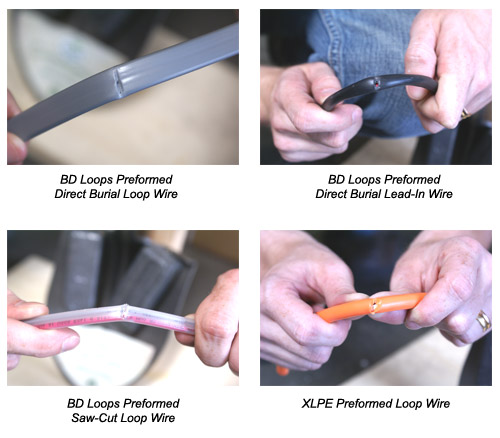Educational Articles
The Importance of Running the Lead-in Through Conduit
The first question I always ask when doing tech support for a suspected inductance loop failure is, “Was the loop lead-in run through conduit?” Unfortunately, many installers skip the important step of running the loop’s lead-in through conduit. Some preformed loop manufacturers don’t even include running the lead-in through conduit in their installation instructions, thinking their jacket and insulation is enough to protect their loop. Running the loop lead-in through conduit adds a lot more protection to a loop system than most would expect.
For direct burial loops the added protection starts day the loop and lead-in is positioned in the base. A careless worker with a sharp shovel, saw, or tool can sever or break the jacket/insulation on the loop. Simply tripping over a loop lead-in could cause damage to the loop by pulling at the yoke (connection, where the loop meets the lead-in). Contractors removing wood concrete forms often use sharp tools such as shovels, picks, hooks, crowbars, or wrecking/landscaping bars that could easily damage the loop lead-in. Often these failures are not discovered until the new surface is completed resulting in having to saw-cut into a brand new surface, which the customer will not be happy to hear. BD Loops makes available on its website a printable warning sign that can be positioned around direct burial loops to make others aware the loops are on the ground hopefully preventing the loops from being damaged by a careless mistake. A good procedure to implement at your company is to test the loops before they are buried. On the BD Loops website we have a printable sign off sheet where installers can record their testing results and have the owner (or foreman) sign off, making a record that the loops were operational when you leave the jobsite.
Running the lead-in through conduit does not solely protect it from dangers associated with pre construction. There is always a chance of the lead-in being nicked or severed days, months, or even years later. An example is a gardener’s shovel or lawn trimmer, which can easily slice through the toughest jacket and cable insulation. Preventing damage to the loop and having a long lasting loop is our goal. This is why BD Loops promotes best installation practice and detailed instructions on how to properly exit the roadway 6-8” below the surface and run the loop lead-in through conduit for added protection.
When adding conduit to a lead-in run on a BD direct burial loop, the PVC conduit should be joined using a proper PVC solvent cement. Having a proper, strong, and permanent joint at the yoke will help prevent a short to ground from occurring should water reach a connection or copper within the loop or lead-in run. Water will always find its way into a conduit, but with a proper conduit joint connection/seal the short will never reach ground (see figure 1). The basic proper procedure for making a solvent-cemented joint seal is both connection points should be clean and sufficient solvent cement should be applied on both joining surfaces. When making the connection the joining surfaces should still be wet. The joint should be left to cure for a period of time before movement/burial. When using the solvent cement, it should not be “jelled” or “stringy” which could fail to make a proper joint. Always follow the manufacturer’s guidelines and instructions.

BD Loops recently conducted a test to compare PVC conduit’s protection against BD Loops jacketed wire and other preformed loop manufacturers jacketed wire. We wanted to find out what the best installation practice (protection) is overall. BD Loops built a “Shovel Guillotine” (see figure 2) that drops a 6lbs shovel at a fixed height. This test would simulate the same amount of force behind each drop giving accurate results. Every jacketed wire we tested was not able to withstand the shovel’s edge. The PVC conduit was able to take three drops with little more than a scratch before we ended the test. The full report can be viewed on the BDLoops.com website.


I would like to emphasize the loop itself should never be run through conduit. Having an air pocket within the loop would allow room for the wires/loop windings to move within the conduit resulting in false detections or detector lockup. These false detections will cause the gate to open by itself and result in a repeat service call for a problem that is very hard to diagnose. There are several articles, tests, and videos about the dangers of air pockets that can be viewed on the BDLoops.com website.

The result of our testing shows that the loop lead-in should always be run through conduit because PVC conduit adds more protection to the loop than a loop’s jacket and insulation alone. Running the loop lead-in through conduit and properly sealing the joint is an inexpensive way to add a lot of protection to the loop installation. Regardless of which loop or preformed loop is being used the lead-in run should be run through conduit for the added protection. If we all continue to follow best installation practices your installations, company, and our industry will have a better reputation and payoff in the long term.
BD Loops
The Loop Experts!
BD Loops was founded in 2001. Their preformed loops and accessories are designed with the installer in mind. BD Loops offers a complete loop system solution including preformed direct burial loops, preformed saw-cut loops, loop sealant, blades, testing devices, and installation tools. BD Loops has a reputation for reliability and ease of installation. They pride themselves on the quality of their products and their commitment to providing excellent customer service and support. BD Loops preformed loops are made in the USA at their facility in Placentia, CA.

